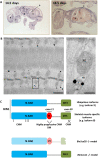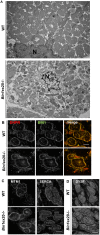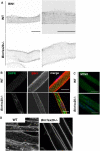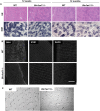Differential physiological roles for BIN1 isoforms in skeletal muscle development, function and regeneration
- PMID: 32994313
- PMCID: PMC7710016
- DOI: 10.1242/dmm.044354
Differential physiological roles for BIN1 isoforms in skeletal muscle development, function and regeneration
Abstract
Skeletal muscle development and regeneration are tightly regulated processes. How the intracellular organization of muscle fibers is achieved during these steps is unclear. Here, we focus on the cellular and physiological roles of amphiphysin 2 (BIN1), a membrane remodeling protein mutated in both congenital and adult centronuclear myopathies (CNM), that is ubiquitously expressed and has skeletal muscle-specific isoforms. We created and characterized constitutive muscle-specific and inducible Bin1 homozygous and heterozygous knockout mice targeting either ubiquitous or muscle-specific isoforms. Constitutive Bin1-deficient mice died at birth from lack of feeding due to a skeletal muscle defect. T-tubules and other organelles were misplaced and altered, supporting a general early role for BIN1 in intracellular organization, in addition to membrane remodeling. Although restricted deletion of Bin1 in unchallenged adult muscles had no impact, the forced switch from the muscle-specific isoforms to the ubiquitous isoforms through deletion of the in-frame muscle-specific exon delayed muscle regeneration. Thus, ubiquitous BIN1 function is necessary for muscle development and function, whereas its muscle-specific isoforms fine tune muscle regeneration in adulthood, supporting that BIN1 CNM with congenital onset are due to developmental defects, whereas later onset may be due to regeneration defects.
Keywords: Animal model; BAR domain; Centronuclear myopathy; Dynamin; Myoblast fusion; Myotonic dystrophy; Myotubular myopathy; SH3 domain; Triad; XLMTM.
© 2020. Published by The Company of Biologists Ltd.
Conflict of interest statement
Competing interestsB.S.C. and J. Laporte are co-founders of Dynacure, and B.S.C. is a Dynacure employee.
Figures








Similar articles
-
Amphiphysin (BIN1) negatively regulates dynamin 2 for normal muscle maturation.J Clin Invest. 2017 Dec 1;127(12):4477-4487. doi: 10.1172/JCI90542. Epub 2017 Nov 13. J Clin Invest. 2017. PMID: 29130937 Free PMC article.
-
Defects in amphiphysin 2 (BIN1) and triads in several forms of centronuclear myopathies.Acta Neuropathol. 2011 Feb;121(2):253-66. doi: 10.1007/s00401-010-0754-2. Epub 2010 Oct 7. Acta Neuropathol. 2011. PMID: 20927630
-
Altered splicing of the BIN1 muscle-specific exon in humans and dogs with highly progressive centronuclear myopathy.PLoS Genet. 2013 Jun;9(6):e1003430. doi: 10.1371/journal.pgen.1003430. Epub 2013 Jun 6. PLoS Genet. 2013. PMID: 23754947 Free PMC article.
-
Centronuclear Myopathy Caused by Defective Membrane Remodelling of Dynamin 2 and BIN1 Variants.Int J Mol Sci. 2022 Jun 3;23(11):6274. doi: 10.3390/ijms23116274. Int J Mol Sci. 2022. PMID: 35682949 Free PMC article. Review.
-
Amphiphysin-2 (BIN1) functions and defects in cardiac and skeletal muscle.Trends Mol Med. 2024 Jun;30(6):579-591. doi: 10.1016/j.molmed.2024.02.005. Epub 2024 Mar 20. Trends Mol Med. 2024. PMID: 38514365 Review.
Cited by
-
Common Pathogenic Mechanisms in Centronuclear and Myotubular Myopathies and Latest Treatment Advances.Int J Mol Sci. 2021 Oct 21;22(21):11377. doi: 10.3390/ijms222111377. Int J Mol Sci. 2021. PMID: 34768808 Free PMC article. Review.
-
Huntington's disease skeletal muscle has altered T-tubules.J Gen Physiol. 2021 Jun 7;153(6):e202012843. doi: 10.1085/jgp.202012843. Epub 2021 May 12. J Gen Physiol. 2021. PMID: 33978682 Free PMC article.
-
Myotonic dystrophy type 1 embryonic stem cells show decreased myogenic potential, increased CpG methylation at the DMPK locus and RNA mis-splicing.Biol Open. 2022 Jan 15;11(1):bio058978. doi: 10.1242/bio.058978. Epub 2022 Jan 12. Biol Open. 2022. PMID: 35019138 Free PMC article.
-
Shaping transverse-tubules: central mechanisms that play a role in the cytosol zoning for muscle contraction.J Biochem. 2024 Feb 25;175(2):125-131. doi: 10.1093/jb/mvad083. J Biochem. 2024. PMID: 37848047 Free PMC article. Review.
-
The Physiology and Pathophysiology of T-Tubules in the Heart.Front Physiol. 2021 Sep 9;12:718404. doi: 10.3389/fphys.2021.718404. eCollection 2021. Front Physiol. 2021. PMID: 34566684 Free PMC article. Review.
References
-
- Al-Qusairi L., Weiss N., Toussaint A., Berbey C., Messaddeq N., Kretz C., Sanoudou D., Beggs A. H., Allard B., Mandel J.-L. et al. (2009). T-tubule disorganization and defective excitation-contraction coupling in muscle fibers lacking myotubularin lipid phosphatase. Proc. Natl. Acad. Sci. USA 106, 18763-18768. 10.1073/pnas.0900705106 - DOI - PMC - PubMed
-
- Amoasii L., Bertazzi D. L., Tronchère H., Hnia K., Chicanne G., Rinaldi B., Cowling B. S., Ferry A., Klaholz B., Payrastre B. et al. (2012). Phosphatase-dead myotubularin ameliorates X-linked centronuclear myopathy phenotypes in mice. PLoS Genet. 8, e1002965 10.1371/journal.pgen.1002965 - DOI - PMC - PubMed
-
- Blondelle J., Ohno Y., Gache V., Guyot S., Storck S., Blanchard-Gutton N., Barthélémy I., Walmsley G., Rahier A., Gadin S. et al. (2015). HACD1, a regulator of membrane composition and fluidity, promotes myoblast fusion and skeletal muscle growth. J. Mol. Cell Biol. 7, 429-440. 10.1093/jmcb/mjv049 - DOI - PMC - PubMed
Publication types
MeSH terms
Substances
LinkOut - more resources
Full Text Sources
Molecular Biology Databases

